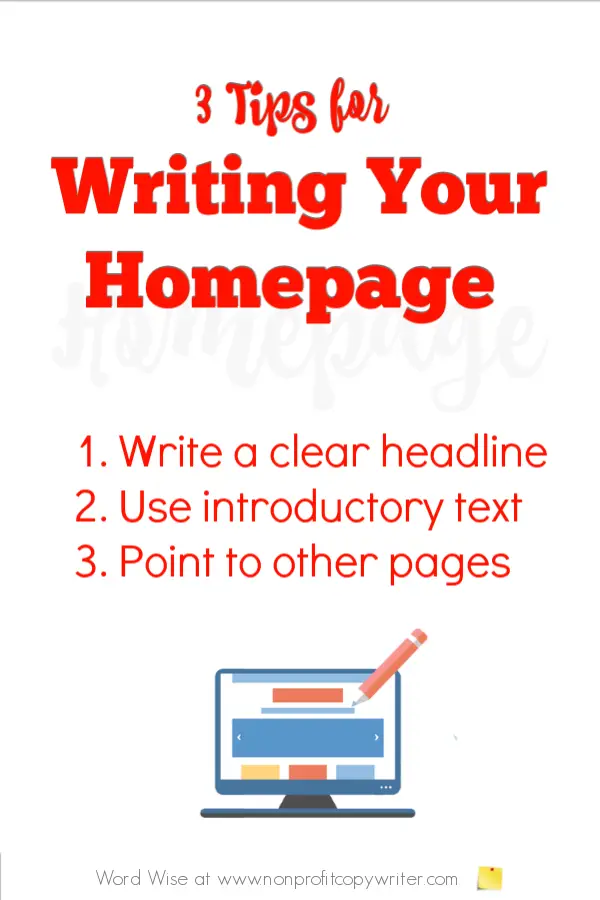Save Time: Get 5 Simple Writing Tips
you can put to use in 10 minutes
3 Tips for Writing Homepage Content: A Quick Tutorial
Award-winning writer Kathy Widenhouse has helped hundreds of nonprofits and writers produce successful content , with 750K+ views for her writing tutorials. She is the author of 9 books. See more of Kathy’s content here.
Writing homepage content is different than writing content for other pages on a site.
A lower-level page has one simple job to do: provide information.
A homepage, too, provides information. But it has two additional jobs to do:
- Tell a visitor that she is in the right place to get answers
- Guide a visitor to other content on the site
Whether a website has five pages or five hundred, the homepage serves as the site’s main entry point. Here is a quick tutorial that will help you write homepage content so that the visitor feels at home and so she knows how to get around your site.
Homepage Content Tip #1: Write a Clear Homepage Headline
When a visitor lands on your homepage, she is looking for something. Because readers go online for information.
Your homepage content needs to quickly communicate what information your site offers. This way, your reader knows she is in the right place.
The most compelling way to do that? Write a clear headline.
Your homepage headline explains your site’s value to your target reader and why your site is different, better, or unique from other similar sites. Since your site cannot be all things to all visitors, write your headline to the audience you want most to reach.
Try to keep your headline to 10 words or less.
Homepage Content Tip #2: Use Introductory Text
You want the visitor to stay for a while, right? It’s important that your homepage content not read as a sales page but more like a friend giving a friend information.
Write introductory text that expands on your headline and gives an overview of what you do. You can use your tagline and a short description that explains the different sections of your site. What are your target reader’s main pain points? Highlight solutions to those problems in your introductory text.
Write clearly and simply so the reader knows you have her in mind. Homepage content is usually 300-1000 words. Less than that, and your visitor won’t know who you are and what you do. More than that and your homepage gets cluttered.
Homepage Content Tip #3: Point to Other Parts of the Site
Friends help friends get to where they need to go. Use your site to point out other areas of the site that might be useful to your reader.
Think of it like this: your website homepage content acts like the hub of a wheel. It is the center of activity on your site, from which other pages radiate. You can guide readers to those other spokes on the wheel – other content on your site – in a variety of ways:
- Use clear navigation so readers don’t get confused
- Weave your website’s top keywords into homepage content
- Build in links to the most-trafficked second level pages
- Include a search box so readers can find content they need
Writing Homepage Content: The Bottom Line
When I write a homepage for a website, I try to put myself in the shoes of a visitor.
- Will she know she’s in the right place?
- Will she know where to go next on the site to get more information?
If I can answer yes, then I’ve got a good start on homepage content.
And readers get a good start engaging on the website, too.
More Writing Tips for Websites
FAQs: Pillar Pages -- what they are and why you need to write them ...
How To Create a Lead Magnet: A Simple Writing Formula ...
12 Tips for Writing Website Content That’s Easy to Read ...
The 3 Types of Links Your Website Needs and How to Build Them ...
The 6 Pages You MUST Have on Your Writing Website ...
3 Things You Need for Planning a Website (or Updating One) ...
Writing Content For a Website: Write These 3 Pages First ...
How to Write Your Website About Page: 10 Writing Tips ...
3 Simple Tips for Writing Better Web Pages ...
Website Tip: how to get your website noticed (a primer) ...
Review: Website Hosting with SBI (Solo Build It) ...
Writing Websites Tips on our Pinterest board ...
Return from 3 Tips for Writing Homepage Content to Nonprofit Copywriter home
As an Amazon Associate I earn from qualifying purchases.
Share This Page

Named to 2022 Writer's Digest list
BEST GENRE/NICHE WRITING WEBSITE


Stop Wasting Time!

Grab your exclusive FREE guide, "5 Simple Writing Tips You Can Put to Use in 10 Minutes or Less"











